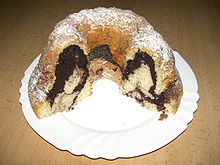Gugelhupf: Difference between revisions
No edit summary |
|||
| Line 20: | Line 20: | ||
[[Category:Sweet breads]] |
[[Category:Sweet breads]] |
||
[[Category:Yeast breads]] |
[[Category:Yeast breads]] |
||
[[Category:Swiss cuisine]] |
|||
[[Category:Czech cuisine]] |
[[Category:Czech cuisine]] |
||
[[Category:German cuisine]] |
[[Category:German cuisine]] |
||
Revision as of 15:20, 22 March 2008


A Gugelhupf or Kugelhupf is a southern German, Austrian, Swiss and Alsatian term for a type of cake. In the Czech Republic it is called bábovka, in Poland it is called babka, in Croatia, Slovenia, Hungary, Bosnia-Herzegovina and Serbia, it is called kuglof. It has the general shape of a torus, like a donut. As with the Jewish dish kugel, the name 'gugelhupf' is related to the Middle High German word kugel meaning "ball" or "globe".
A common Gugelhupf consists of a soft yeast dough and contains raisins, almonds and Kirschwasser. Some also contain candied fruits and nuts. It is baked in a special circular pan, originally made of enamelled pottery, now also used for making Bundt cakes. It is usually eaten for breakfast or a coffee break.
It was the sweet chosen to represent Austria in the Café Europe initiative of the Austrian presidency of the European Union, on Europe Day 2006.
